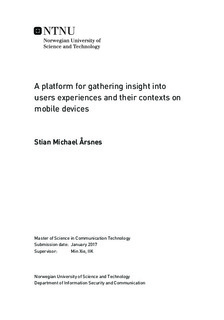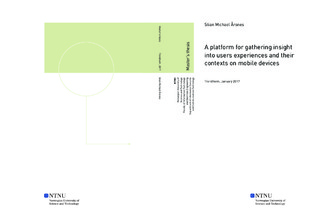| dc.description.abstract | Users are getting more demanding every day, and it is more important than ever for providers to really understand what their users feel and think when using their product, application or service. This why \gls{qoe} has become more important the last few years. There is a variety of tools that help providers to retrieve \gls{qoe} and \gls{qos} data from users, but most of them are too rigid, too specific or offer little flexibility for providers to answer questions that are important to them. There are large amounts of metadata that may be collected from mobile devices. Some of this data can be used to identify issues that cause poor user \gls{qoe}. When issues are identified, they can be managed by the provider to prevent future annoyance, which will result in higher user retention. So how can we give providers the flexibility they need to associate metadata that helps them together with user feedback, so they may properly understand their users needs?
In this study we show a possible solution developed with the flexibility of the provider in mind. We developed a \gls{qoe} feedback platform which allows providers to collect their own data, and answer questions that are important to them, by letting providers define their own feedback alternatives. With one line of code we provide providers with a two-way communication between the platform and \glspl{papp}. With the communication, the platform is able to receive data specific to \glspl{papp}, which we otherwise would not be able to collect, or possibly even predict would be important to the provider. This data can be used by the providers to answer questions, and discover relationships between collected provider data and the users \gls{qoe} feedback. We also give providers control over how resources are used on users devices, by letting them enable or disable what types context data the platform should gather in the background.
After developing the changes to the platform we tested it in two different user tests using two different test applications that we developed. The tests show us that the concept works, and seem to confirm that the platform is non-intrusive to users. The resulting platform has become a non-annoying, discrete, lightweight platform which provides providers with flexibility to determine how and what to measure. | |

